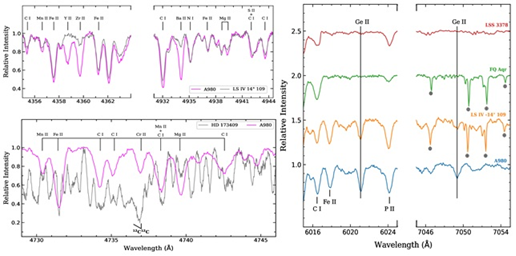Far away in the Ophiuchus Constellation, a peculiar star named A980, 25800 light years away, is rewriting what we know about stellar chemistry. Researchers have uncovered a cosmic twist -- this mysterious star that belongs to a rare class called Extreme Helium (EHe) stars, carries surprisingly high amount of germanium—a metallic element never before observed in this type of star.
A980 was initially thought to be a hydrogen-deficient carbon star, a peculiar breed of cool star that lacks hydrogen—the most common element in the universe.
A closer look by astronomers from the Indian Institute of Astrophysics (IIA), an autonomous institute of the Department of Science and Technology (DST) using the Hanle Echelle Spectrograph on the Himalayan Chandra Telescope in Ladakh, showed something strange. Its spectrum—essentially a stellar fingerprint—did not match what they expected.
Instead, the pattern looked a lot like that of another rare type of star, LS IV -14° 109, a known cool EHe star. These stars are so rare that only a handful have been identified. What makes them special is that they are almost entirely made of helium, and they are likely formed when two white dwarf stars—one carbon-oxygen rich and the other helium-rich—merged in a spectacular cosmic collision.
The team also spotted something no one had ever seen before in an EHe star -- singly-ionized germanium (Ge II) lines. This means that germanium atoms in the star had lost one electron, leaving a distinct trace in the star’s spectrum.
“We were surprised to see singly-ionized germanium (Ge II) lines in the A980’s optical spectrum. These are the first-ever detections of germanium lines in an EHe’s observed spectrum, and provide the first measurements of germanium abundance in an EHe star,” said Gajendra Pandey, the co-author of the study and thesis supervisor of his Ph. D student, Ajay Saini.

Fig: The observed spectra of LS IV -14° 109, a known cool EHe, and A980 are displayed for comparison in the top left panel. In the bottom left panel, the observed spectra of HD 173409, a known HdC, and A980 are shown in the (1, 0) C2 band region for comparison. In the right panel, the Ge II λ6021.04 and λ7049.37 Å lines in A980, along with those in other cool EHes such as LS IV -14° 109, FQ Aqr, and LSS 3378, are highlighted with vertical lines.
They found that germanium is eight times more abundant in A980 than in the Sun, which is evidence for the synthesis of germanium in EHe stars. Also, A980 showed a maximum enhancement of the s-process elements based on a significant number of spectral line transitions among the known cool EHe stars.
“Germanium has never been detected in these stars before, and here it was—eight times more abundant than in our own Sun! said Ajay Saini, who led the study.
EHe stars are thought to originate from the merger of a carbon-oxygen white dwarf with a less massive helium white dwarf. The detection of germanium offers new clues for exploring other plausible scenarios”, he explained.
This incredible find suggests that A980's past includes some heavy-duty cosmic chemistry, likely involving a process where atomic nuclei slowly capture neutrons—the s-process, a known method of forging elements which are heavier than iron.
The researchers suspect that A980’s unusual chemistry could trace back to a phase in stellar evolution called the Asymptotic Giant Branch (AGB)—a stage when stars puff up and start producing heavy elements like barium, strontium, and germanium. These stars eventually shed their outer layers, and their cores become white dwarfs.
The study proposes that A980 could be the result of a merger between a helium white dwarf and a carbon-oxygen white dwarf—an event dramatic enough to stir up and distribute these rare elements.
But there's another possibility. Thorne-Żytkow Objects (TŻOs)—theoretical hybrid stars that have a neutron star at their core—are also known to produce lots of germanium, using a different method called the rp-process (rapid proton capture). While A980 does not fully match the expected properties of a TŻO, the similarities are intriguing.
Heavy elements like germanium are forged in the crucibles of dying stars, and every new clue helps astronomers’ piece together the cosmic story of how matter came to be. By identifying germanium in A980, scientists now have a new puzzle to solve—one that might deepen our understanding of how rare stars evolve and what happens when white dwarfs collide.
“This discovery pushes the boundaries of what we thought we knew about stellar chemistry,” said Dr. Gajendra Pandey, the study’s co-author. “It also shows how powerful high-resolution spectroscopy can be used in uncovering the hidden stories written in starlight.”
The research has been published in The Astrophysical Journal and marks a major milestone for the Indian Institute of Astrophysics—illuminating not just a single star, but a whole new frontier of stellar evolution.
Publication link: https://doi.org/10.3847/1538-4357/ada1c2
For more details, contact Dr. Gajendra Pandey (pandey[at]iiap[dot]res[dot]in).






























